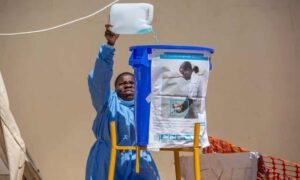
In the 1840s, a prominent health notion of the time – the “miasma theory” – suggested that bad smells and bad air led to people contracting diseases such as cholera and the Black Death. By the end of the decade, more than 50,000 deaths had been recorded in England and Wales.
In 1849 John Snow – a young physician considered one of the founders of modern epidemiology – had become sceptical of the prevailing theory and suggested that contaminated water may instead be the main form of transmission.
Using a geographical grid to chart deaths in a cholera outbreak in London, Snow identified a water pump as the source of the epidemic. The pump was removed, the epidemic collapsed, and legislation was put in place to build water and sewage systems in London and beyond, which prevented future outbreaks. By the end of the 19th century, the first vaccines for cholera were developed. Unfortunately, that is not the end of the story.
Cholera continues to take lives, and now, after years of progress, it has returned with a vengeance, with 30 countries reporting deadly outbreaks since the beginning of 2024. Conflict, poverty, the climate crisis and global socioeconomic inequities are all underlying reasons why outbreaks tend to be larger and deadlier.
The supply of vaccines, which along with improved sanitation and hygiene are key to preventing cholera outbreaks, has run out. In October 2022, the International Coordinating Group on Vaccine Provision, which manages emergency stockpiles, suspended the standard two-dose vaccination regimen in favour of a single dose. Despite this extreme measure to stretch supplies, at the start of this year the stockpile was empty.
Zero doses are left, as 15 countries are reporting active outbreaks. And while more than 1 billion lives are at risk from cholera, pharmaceutical companies are not serving the cholera market due to its low profitability – a consequence of a disease that affects the poorest of the poor.
While the poverty and conflict triggers for cholera are well known, we also face a growing threat of the climate crisis. Extreme events such as floods, cyclones and droughts further reduce access to clean water and create the ideal environment for cholera to thrive.
There has been progress in some outbreak countries, but there is great concern over the epidemics in the Democratic Republic of the Congo, Ethiopia, Mozambique, Somalia, Sudan, Zambia and Zimbabwe. Along with the global shortage of oral cholera vaccines, other supplies are running low too. Health workers remain overstretched as the growing number of humanitarian emergencies push health systems to breaking point.
The World Health Organization (WHO) and Zambia are together championing the Global Task Force on Cholera Control, which has worked with national authorities to stop outbreaks – ensuring access to essential supplies, upgrading the detection, prevention and treatment of cholera, keeping people informed on how to protect themselves, and setting priorities to sustainably control cholera.
This is a strong foundation, but with equally challenging headwinds, there is more to do. First, public health basics are critical. Just as Snow noted centuries ago, it’s important to ensure safe water, sanitation and hygiene. This means investing in major infrastructure projects, while working directly with communities to co-produce solutions that serve their needs.
Second, as cholera spreads so rapidly, honing a surveillance system that can detect outbreaks quickly is important. Well-equipped laboratories and access to diagnostic tests are the first steps to deliver effective treatment and rollout vaccines precisely where they are needed.
Third, the lack of vaccine production capacity is hindering our responses to outbreaks and our ability to run prevention campaigns. In the medium to long term, it remains important to increase global vaccine production. Currently, Zambia is waiting for the production of vaccines to protect at least 2.4 million people at risk of contracting cholera. With vaccine stocks empty since January, any new outbreak will add pressure to this fragile ecosystem.
